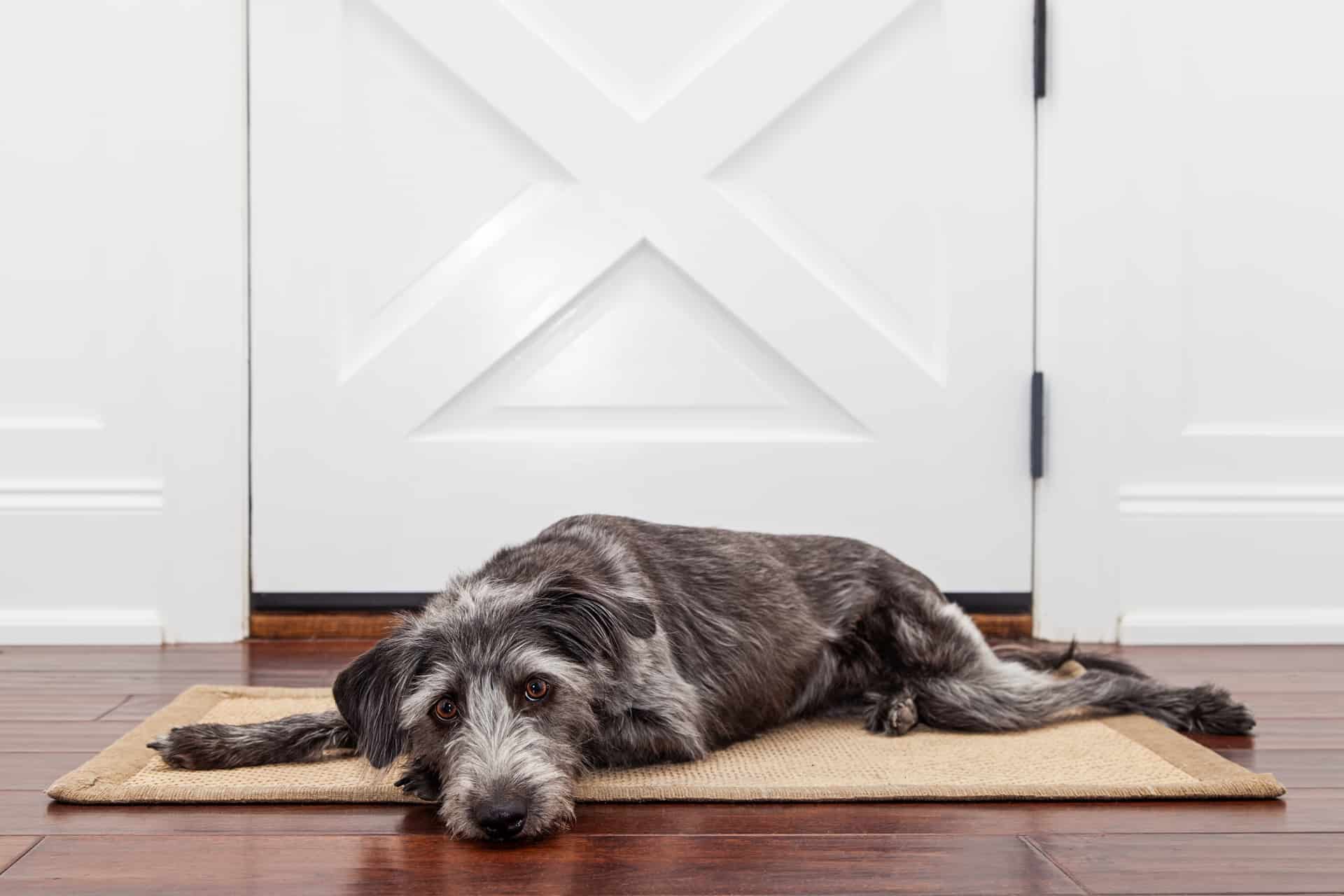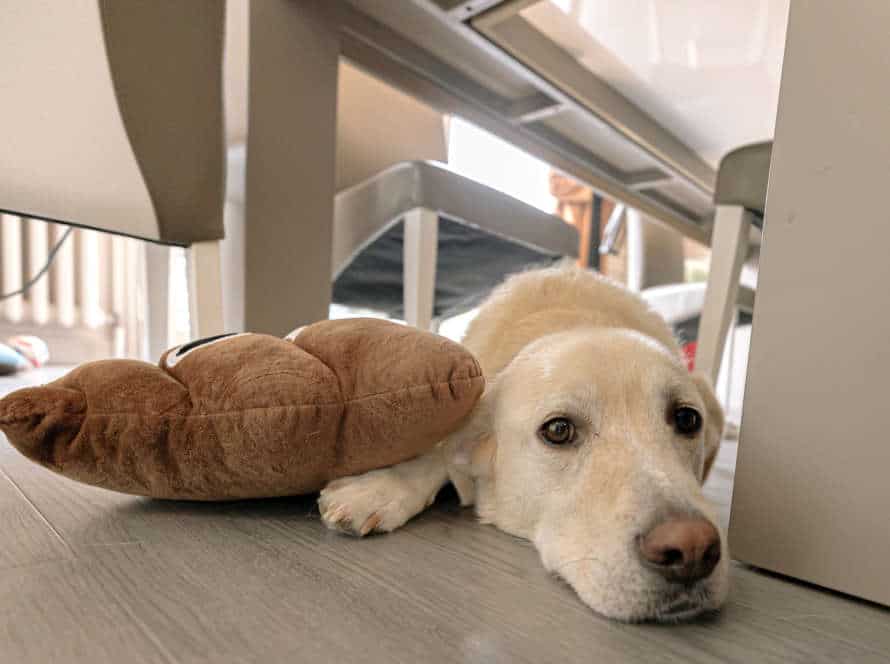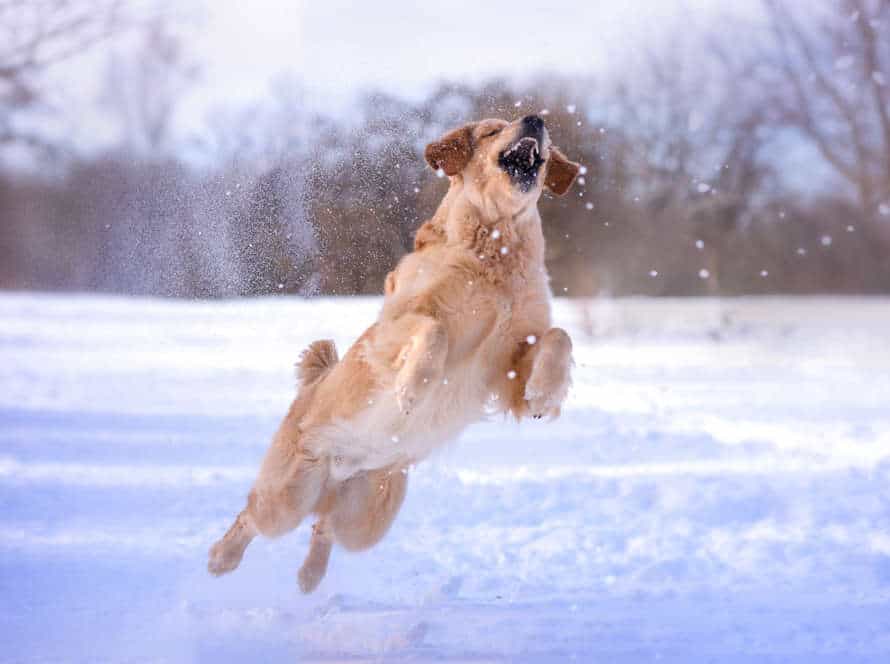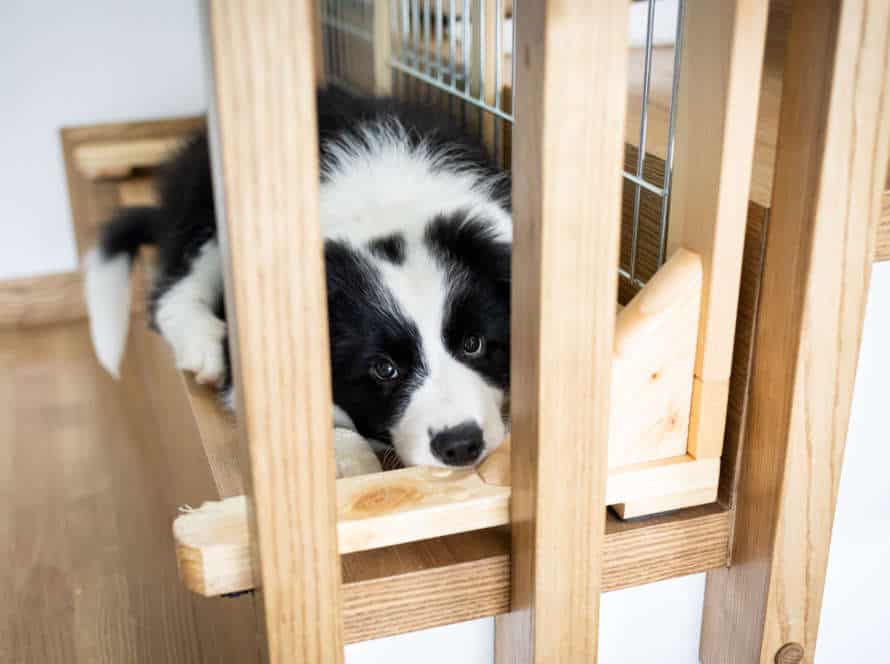Managing Separation Anxiety in Senior Dogs
Separation anxiety in senior dogs can be tough. Here are some tips to help:
- Start short, then increase time alone gradually
- Exercise & mental stimulation before leaving.
- Give a safe, comfy spot like a crate or area.
- Check out natural remedies like sprays or music.
- For severe cases, vet-prescribed medication is an option.
Remember: be calm & consistent. Pets pick up on emotions, so a relaxed attitude helps reduce stress.
Understanding Separation Anxiety in Senior Dogs
Separation anxiety can affect dogs of all ages. But, senior pups are more prone to it. Knowing the signs of separation anxiety is crucial for keeping your elderly dog feeling safe and secure.
Let’s dive further into this matter.
Causes of Separation Anxiety in Senior Dogs
Separation anxiety is a common problem for older pups. It can have many reasons. Changes in routine or environment, medical issues, and socialization are some of the most common.
Alterations in their normal routine or living space can make senior dogs anxious and uncertain. Medical difficulties such as hearing loss, vision loss, and cognitive decline can also cause distress and make them need more attention from their owners.
If they don’t socialize with other dogs, they may attach too much to their human and be anxious when left alone. To help these dogs, a regular routine and environment should be established. Check with the vet if any medical issues are present. Socialization opportunities are also important. If symptoms are severe, medication or professional training may be needed.
Symptoms of Separation Anxiety in Senior Dogs
Senior doggos may be more prone to separation anxiety. Here are symptoms to watch out for:
- Excessive noise like barking, howling or whining when left alone
- Destructive behavior like chewing furniture or door frames
- Scratching doors or windows to get away
- Pacing or restlessness when alone
- Not eating or drinking when left
- Going potty inside when usually housetrained
- Drooling or salivating when apart from the owner
If your senior pup shows these signs, there are ways to manage it. Ask your vet for advice. Use positive reinforcement training. Gradually increase time away from pup. And remember to be patient and consistent.
Dangers of Ignoring Separation Anxiety in Senior Dogs
Separation anxiety in senior dogs can cause lots of issues. These include destructive behavior like barking, digging, pacing and peeing inside. It can also impact their physical health with weight loss and digestive issues.
So, it’s important to watch out for signs like whining, agitation and following the owner around. Early management is key to help senior dogs. This could involve behavior modification or medicine. It will improve their physical and emotional health. Hence, it’s essential to address separation anxiety in senior dogs quickly, to avoid long-term problems.
Treating Separation Anxiety in Senior Dogs
Senior dogs can suffer from separation anxiety, just like young dogs. It can be tough to cope with, and stressful for both pet and owner. To make it easier, here are some helpful tips and treatments. Let’s check them out!
- Exercise: Ensure your senior pup gets plenty of physical activity.
- Structure: Maintain a consistent routine.
- Comfort: Provide a safe and comfortable spot for your dog.
- Comfort Items: Give them their favorite toys or blankets.
- Aromatherapy: Use calming scents such as lavender to help them relax.
- Counter Conditioning: Praise and reward your senior pup when they’re calm and relaxed.
- Professional Help: Consider seeking professional help if the anxiety is severe.
Behavior Modification Techniques for Senior Dogs
Just like us, senior dogs can have separation anxiety as they age. Thankfully, there are several behavior modification methods to help manage and treat this. Here are some to try:
- Counter Conditioning: Turn being alone into a positive experience. Give your pup a special treat or toy that only comes out when you leave.
- Gradual Desensitization: Get them used to longer periods of alone time. Start with a few minutes at a time and gradually increase it over several weeks.
- Medication: In serious cases, medication prescribed by a vet may be needed for managing the anxiety.
It’s important to work with your vet to find the best course of action for your senior pup’s separation anxiety.
Gradual Desensitization
Gradual desensitization is a way to help senior dogs handle separation anxiety. It trains them to get used to being alone, bit by bit. Here are the steps:
- Start with a short time away – just 5 minutes.
- Increase the time away by 5-10 minutes every time.
- Give a treat or toy while you’re away to keep them busy.
- Eventually, they’ll be ok with longer times alone.
- Take your time and be patient – it can take weeks or months.
Counterconditioning
Counterconditioning is a way to manage separation anxiety in senior dogs. It trains your pup to see being alone as something positive, not negative. Here’s how:
- Start small – even just a few seconds – and give your dog a treat or puzzle toy before you go.
- Gradually increase the time away.
- This way, your pooch will learn that being alone means a reward.
- For best results, stay patient and consistent. If needed, seek help from a professional.
Training Techniques
Training techniques are vital for managing and treating separation anxiety in elderly dogs. Three techniques that have been successful are counterconditioning, desensitization, and positive reinforcement.
Counterconditioning involves altering your pup’s emotional response to being alone. Do this by pairing alone-time with something they like, like a treat, toy, or activity.
Desensitization means exposing your dog to being alone for brief periods. Gradually increase the length of time they’re alone. This can help them get used to it.
Positive reinforcement involves rewarding your dog when they’re calm or alone for a short time. This can reinforce good behavior and reduce anxiety.
Every dog is unique. Separation anxiety may need a mix of these techniques, combined with patience and consistency, to improve.
Medications for Senior Dogs with Separation Anxiety
Senior dogs can suffer from separation anxiety. But, medications exist to help manage their symptoms and improve their quality of life. Use the meds in combination with behavior modification and training. Here are 3 common medications for treating separation anxiety in senior dogs:
- Fluoxetine: This alters brain chemicals related to anxiety, to calm the dog down. It takes a few weeks to take effect. Remember to keep giving it as prescribed.
- Trazodone: Give it for short-term relief. It calms the dog in 30-60 minutes. Follow the vet’s instructions when administering.
- Alprazolam: It’s often given to dogs with bad separation anxiety. It binds to brain receptors, calming the dog. Use caution and monitor liver and kidney function in senior dogs.
Commonly Prescribed Medications for Senior Dogs
Senior dogs with separation anxiety can be tricky to manage. Medication may help, though! Vets often prescribe:
- Fluoxetine. It’s an SSRI which raises serotonin levels in the brain, managing mood and anxiety.
- Clomipramine. This antidepressant helps balance mood and reduce anxiety.
- Alprazolam. A sedative benzodiazepine, it relaxes and reduces anxiety.
Note: Meds can cause side effects like drowsiness, fatigue, and GI problems. For best results, combine medication with behavior modification techniques like desensitization and counterconditioning.
Potential Side Effects of Medication
Medication can help manage separation anxiety in senior dogs. But, it is important to know the side effects that could occur. Common side effects include:
- Drowsiness. This makes it tough for pups to stay awake or act normally.
- Digestive problems. These include vomiting and diarrhea, which can bring discomfort and dehydration.
- Loss of appetite. This can lead to weakness and malnutrition.
- Increased aggression. Rarely, this may be a sign of a pup trying to cope with their anxiety.
It is a good idea to talk to your vet about treatment options and side effects before giving your dog any medication.
Consulting with a Veterinarian
Consulting a vet is key when treating and managing separation anxiety in senior dogs. They can help determine if any medical issues are causing the anxiety, prescribe medication, and create a behavior modification plan. Vets can also refer owners to a dog behaviorist. Lastly, regular follow-up appointments can monitor progress and adjust the treatment plan.
Combination Therapy for Senior Dogs with Separation Anxiety
Combination therapy is a good way to treat senior dogs with separation anxiety. It’s a common behavior disorder that can be damaging for a pet’s health and their home environment. Here’s what combination therapy means:
- Behavioral modification- Training and conditioning techniques can help a dog feel better when by themselves.
- Medication- Anti-anxiety drugs can soothe a dog’s nerves and ease the symptoms of anxiety.
- Supplements- Natural supplements can reduce anxiety and make a senior dog more relaxed.
- Environmental enrichment- Give a dog toys, chews, and interactive puzzles to keep them busy and calm.
By combining these approaches, you can manage separation anxiety in your senior pup, and give them the care they deserve.
Benefits of Combination Therapy
Combination therapy is an approach that uses multiple therapies or meds to help treat separation anxiety in senior dogs. It brings several benefits:
- Better symptom relief – combining behavior mod, changes in the environment and medication can help reduce symptoms more than a single treatment.
- Lower med dosage – using a combo of therapies and meds can allow for a lower dosages, reducing side effects.
- Addresses underlying issues – this approach can help identify and address issues that may be contributing to anxiety, like pain or health problems.
- Higher success rate – using multiple therapies or medications increases the chances of success.
Remember to speak to your vet first before starting any treatment. Pro Tip – combination therapy does not work for all, so it is important to work with your vet to come up with a personalized plan that’s right for your dog.
Factors to Consider before Combining Techniques
Combining techniques for treating senior dogs with separation anxiety can be effective. But, there are a few things to keep in mind.
- First, measure the severity of separation anxiety. If it’s mild, one technique might be enough. For more serious cases, combine multiple techniques.
- Second, personalize your approach. What works for one dog might not work for another. So, tailor the techniques to your dog’s needs and personality.
By considering these factors, you can create a personalized approach that has the best chance of helping your senior dog with their separation anxiety.
Managing Separation Anxiety in Senior Dogs: Prevention Techniques
Senior dogs can suffer from separation anxiety. This can be tough on both pup and owner, and can cause destructive actions and even health problems. The positive news is, pet owners can take steps to help avoid it. In this article, we’ll see ways to stop separation anxiety in senior dogs and how to manage it if it happens.
Establishing a Routine for Senior Dogs
To help senior dogs manage separation anxiety, a routine is necessary. Here are some tips to make one that works:
- Feed your pup at the same time and place daily.
- Go for regular walks at the same time and route.
- Keep them entertained with interactive toys and puzzles when you’re not home.
- Before leaving for a long time, let your pup get used to it by increasing the time away from them gradually.
- Hire a dog sitter or take them to doggy daycare when you’re away for extended periods.
Pro Tip: With a regular routine, senior dogs are more calm and secure and this lessens the risk of separation anxiety.
Offering Calming and Soothing Features in the Home
To manage separation anxiety in senior dogs, try adding calming & soothing features to the home. Here are a few tips:
- Create a cozy space. Set aside a spot with blankets, toys & treats.
- Play soft, soothing music. See which genre works best.
- Use aromatherapy. Natural scents like lavender, chamomile & bergamot can help.
- Try a Thundershirt. A snug-fitting garment provides calming pressure.
- Most of all, give your dog enough exercise, playtime & attention. A tired & happy dog is less likely to experience anxiety.
Consistently Reinforcing Positive Behaviors in Senior Dogs
Reinforcing positivity is a great way to combat separation anxiety in senior dogs. Here are some tips:
- Practice leaving your pup alone for short intervals, rewarding them for remaining relaxed.
- Designate a cozy place for them to rest when you’re not there – such as a bed or crate.
- Play calming music or leave the TV on when you’re away to create a peaceful atmosphere.
- Give puzzle feeders or toys to occupy them while you’re gone.
- Look into natural remedies to reduce anxiety, like pheromone sprays or essential oils.
By always rewarding good behavior and providing a comfy environment, you can manage separation anxiety and make sure your senior pup has the best golden years!
Frequently Asked Questions
1. What is separation anxiety in senior dogs?
Separation anxiety is a behavior in dogs characterized by excessive distress, anxiety, and fear when left alone or separated from their owners. In senior dogs, this condition may develop due to age-related changes in behavior and/or cognitive function.
2. What are the signs of separation anxiety in senior dogs?
The signs of separation anxiety in senior dogs include excessive barking, whining or howling when left alone, destructive behavior (such as chewing or digging), house-soiling, pacing, panting, and trembling.
3. How can I manage separation anxiety in my senior dog?
You can manage separation anxiety in your senior dog by gradually desensitizing them to your absence, establishing a routine, providing plenty of exercise and mental stimulation, ensuring a comfortable environment (such as a cozy dog bed), using calming aids (such as natural supplements, music, or pheromones), and seeking professional help if necessary.
4. Is medication necessary to manage separation anxiety in senior dogs?
While medication may be helpful in severe cases, it is not always necessary to manage separation anxiety in senior dogs. Many dogs can learn to cope with their anxiety through behavior modification and environmental changes.
5. Can separation anxiety be prevented in senior dogs?
While separation anxiety cannot always be prevented in senior dogs, there are steps you can take to reduce the risk. These include socializing your dog from a young age, establishing a routine, providing plenty of mental stimulation and exercise, and making sure your dog feels comfortable and secure in their environment.
6. What should I do if my senior dog shows signs of separation anxiety?
If your senior dog shows signs of separation anxiety, it is important to address the issue promptly to prevent it from worsening. Try implementing the management strategies listed above, and consider seeking professional help from a veterinarian, animal behaviorist, or dog trainer if necessary.







